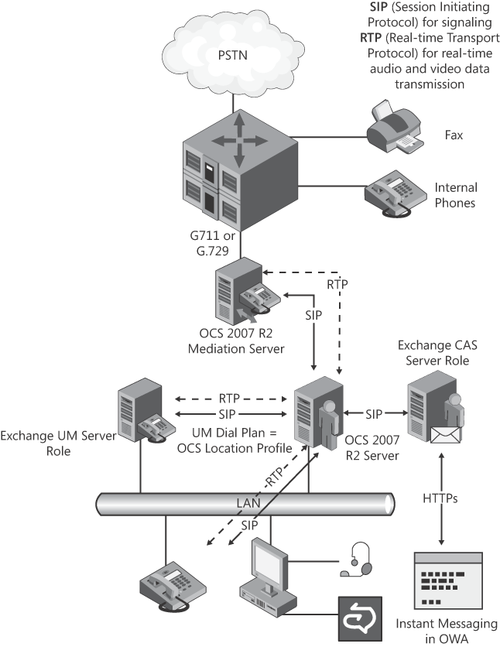Exchange Server 2010 UM provides OCS 2007 R2 with the voice mail feature, and OCS 2007 R2 can make presence information and instant
messaging features available to your OWA users. You can also configure
an automatic switchboard for your OCS 2007 R2 voice-enabled users using
an UM auto attendant.
UM can also utilize an existing IP
PBX that is configured with OCS 2007 R2—you do not need additional
hardware to connect UM to your PBX if OCS 2007 R2 is installed already.
Thus any PBX configuration can be managed from the OCS 2007 R2 side,
and does not need to be configured again in Exchange 2010.
OCS 2007 R2 also provides other features that integrate into UM:
Instant messaging
The OCS 2007 R2 client provides instant messaging (IM) functionality
that the OCS hosts. The solution provides IM features, such as group
IM, and extends the internal IM infrastructure to external IM
providers. You can implement IM directly into OWA.
Presence information
OCS 2007 R2 tracks presence information for all OCS users and provides
this information to the OCS 2007 R2 client and other applications, such
as Outlook 2007. You can implement presence information directly into
OWA.
Web conferencing
OCS 2007 R2 can host on-premise conferences, which you can schedule or
reschedule, and they can include IM, audio, video, application sharing,
slide presentations, and other forms of data collaboration.
Audio conferencing
Users can join OCS 2007-based audio conferences using any desk or
mobile phone. When connecting to an audio conference using a Web
browser, users can provide a telephone number that the audio-conferencing services calls.
VoIP telephony Enterprise
Voice enables OCS 2007 R2 users to place calls from their computers by
clicking an Outlook or Communicator contact. Users receive calls
simultaneously on all their registered user endpoints, which may be a
VoIP phone, a mobile phone, or an OCS 2007 R2 client. The OCS 2007 R2
Attendant is an integrated call-management client application that
enables a user, such as a receptionist, to manage many conversations
simultaneously.
Response Group service
This service enables administrators to create and configure one or more
small response groups for routing and queuing incoming phone calls to
one or more designated agents. Typical scenarios include an internal
help desk or customer-service desks.
|
Korneel Bullens
Team Coordinator Unified Communications, Wortell, Netherlands
One of the things I am always
asked about is when deploying OCS Enterprise Voice as PBX replacement;
the users still require an extension number. When you configure the UM
dial plan for OCS connectivity, you select SIP dial plan as the URI
type and you still need to configure the number of digits in extension
numbers for the UM dial plan. Many of the administrators I talk to
would not expect to be asked for an extension number in an OCS- and
UM-only scenario.
When you think about it,
it's quite logical. You need a unique identifier when someone calls his
voice mail from outside the company, and needs to select his own voice
mail box. This is when the extension number comes into the game. You
are free to assign your own extension numbers, just make sure when you
create the UM dial plan, the amount of digits suits your needs. If you
deploy 120 users for UM, use only three digits. Fewer digits mean fewer
numbers to remember for your users.
|
1. Integrating OCS 2007 R2 in Exchange 2010 Architecture
Exchange 2010 UM completes the offering of OCS 2007 R2 with a voice mail solution based on messaging.
This requires a tight integration between OCS 2007 R2 and Exchange 2010
UM. Together with the integration of IM in OWA, OCS 2007 R2 can be
described as being fully connected to Exchange Server 2010, as shown in
Figure 1.
The UM role communicates to the OCS Mediation server using the OCS Pool Name and thus contacts the OCS Front-End server. All signaling communication (SIP) and the voice stream (RTP) pass the OCS Front-End server.
When Office
Communicator clients access their voice mail mailbox, they also do not
directly contact the Exchange UM server role. Their communication is
also handled by the OCS Front-End server.
Note:
For
more details about the communication between OCS 2007 R2 and UM, you
can access the Office Communications Server 2007 R2 Workload
Architecture Poster at http://www.microsoft.com/downloads/details.aspx?displaylang=en&familyid=af2c17cb-207c-4c52-8811-0aca6dfadc94.
